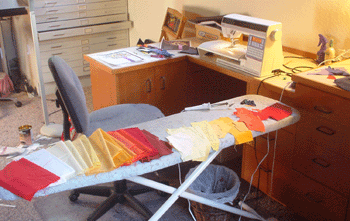| Creating the Candle Quilt My first design for the candle was very much inspired by Käthy Gubler's guilt, "Waves", which is one of the great examples in Barbara Kaempfer's book, LOG CABIN WITH A TWIST. Käthy's quilt features a square of color, twisting and turning against a dark background. It is very suggestive of waves, but also flames. I thought a frame of flame-like shapes around my short poems about the candle and fireplace might be nice. I started with my poem in the center and began building the frame of triangles, some of which I know will become parallelograms. |
All
images and text © Anna Grossnickle Hines 2005

|
The parallelogram fills the space of two triangles and gives a different shape to the twist. In this design the triangle can point to the left or the right and can twist either clockwise or counter clockwise. The parallelogram twists clockwise or counter clockwise and can be placed horizontally, leaning to the right or left, or vertically. |

|
That gives a lot of possibilities for varying twists and turns! Here I've built my frame with both triangles and parallelograms and have just begun to fill the spaces with color. As I recall I started working against the pink background so I could see both the black lines of my design and the white type of the poem (which is hidden in this version). |
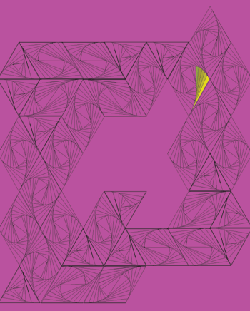
|
With all the spaces filled in the design is quite striking. |
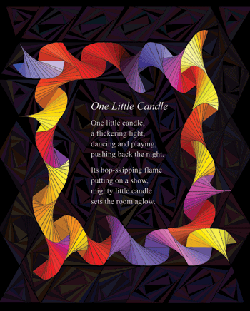
|
The two pages would look like this. But when I got the feedback from the publisher this design was out. As impressed as they were they felt it would be much better to be able to see the candle and the fire on the logs. |
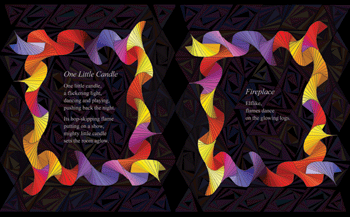

|
Now I'm pretty well settled on the flame and main part of the halo, but would like the light to spread out just a bit further somehow. |
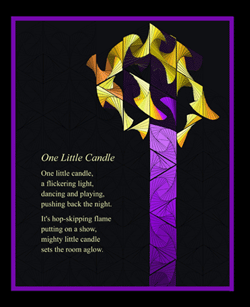
|
I experimented with some yellow mixed in with the darks, but it is too distracting. |
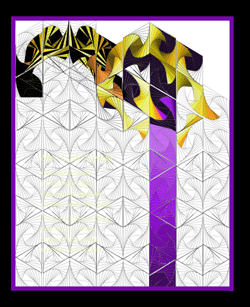
|
I scanned some dark colored fabrics, and tried filling the background spaces with those. Interesting, but not what I want. |

|
Finally, I came up with the idea of using deep blues and grays and making them twist into the dark background the same as the halo around the candle. I like it. Now I'm ready to sew. |
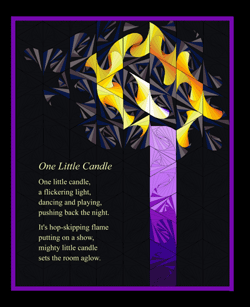
|
I printed sheets of parallelograms and triangles on Fundation™. These triangles are larger than those in the Solstice quilt, 1 7/8 instead of 1 3/8 inches, so it didn't take nearly as many. They have one more twist though, so each one has 16 pieces rather than 13. Each parallelogram, also |

|
I printed my design without the black background to use as a guide in putting the quilt together. Since those stiff seams wouldn't flatten completely my quilt came out a bit narrow. I changed some of the top pieces from triangles to parallelograms, filled in few extra triangles and made one more mixed row which I cut in half and added along each side. I think the total number of parallelograms in the guilt is 64, and 41 triangles. |

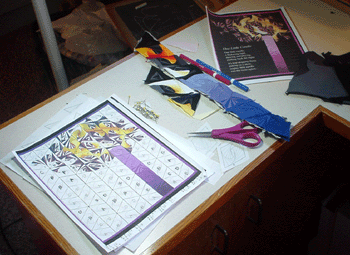
|
Labeling the counter clockwise triangles "C", the clockwise "D", and the parallelograms "A" and "B" was very helpful. I marked my chart with those letters, too, then I didn't have to think so hard as I selected each foundation piece. |
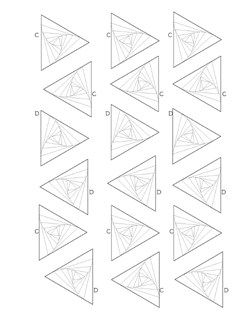
|
For some of the flames I needed a run of seven colors in the yellow to red range. My ironing board made a good sorting and working space. With those small pieces and my little mini-iron, I didn't need a large pressing surface. |
